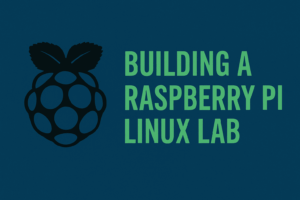
Build a Home Linux Lab with Raspberry Pi
Turn your Raspberry Pi into a portable Linux lab using Raspberry Pi Imager. This guide walks you through flashing the OS, enabling SSH, configuring Wi-Fi, and getting the system ready for headless or desktop use.
🔧 What You’ll Need
-
Raspberry Pi 3B, 4, 400, or 5
-
microSD card (16GB minimum, 32GB+ recommended) or USB SSD
-
Raspberry Pi Imager (on Windows/macOS/Linux)
-
USB keyboard, HDMI cable, and monitor (for first boot if not headless)
-
Wi-Fi or Ethernet access
Step 1: Download Raspberry Pi Imager
-
Download the Imager for your OS.
-
Install and launch the application.
Step 2: Choose Your OS Image
-
Click “Choose OS”.
-
Scroll to Other general-purpose OS > Ubuntu.
Step 3: Choose Storage
-
Insert your microSD or USB drive.
-
Click “Choose Storage” and select the correct device.
⚠️ Warning: This will erase the entire drive.
Step 4: Preconfigure Settings (Wi-Fi, SSH, Hostname)
-
Click the ⚙️ gear icon in the bottom-right of Raspberry Pi Imager.
-
Enable:
-
Set hostname: e.g.
homelab-pi -
Enable SSH: Select password or public key auth
-
Set username and password
-
Configure Wi-Fi: Enter SSID, password, and country
-
Optional: Set locale and timezone
-
-
Click Save to store these settings before flashing.
🧠 This step makes it headless-ready out of the box.
Step 5: Flash the Image
-
Click “Write”.
-
Confirm when prompted.
-
Wait for it to complete (5–15 minutes).
Step 6: Boot the Raspberry Pi
-
Insert the SD/USB into your Raspberry Pi.
-
Connect power and optionally HDMI/keyboard.
-
First boot may take a few minutes while it resizes partitions.
Step 7: Connect via SSH (Optional)
If you enabled SSH and Wi-Fi:
If .local doesn’t resolve, find your Pi’s IP from your router and use:
Step 8: Post-Setup Essentials
Once you’re in:
Optional installations (depending on use-case):
Desktop environments for Server editions:
For Kali or Parrot, skip this—they come preloaded with tools.
🧪 Use Case Ideas for Your Home Lab
-
🔍 Run pentesting tools (Kali/Parrot)
-
🧠 Practice system hardening
-
🛡️ Build and test firewall rules
-
🧰 Host your own DNS, VPN, PiHole, or web server
-
🧪 Test scripts in a controlled Linux sandbox
💡 Tip: Make It Modular
Want to switch OS easily? Flash new images to other SD cards or USB sticks and hot-swap. Use PiBakery or scripts to preconfigure more complex setups.
🧩 Compatible Distros
This guide works with:
-
✅ Ubuntu Desktop / Server
-
✅ Kali Linux
-
✅ Parrot OS Home / Security
-
✅ Raspberry Pi OS
-
✅ DietPi
-
✅ Arch Linux ARM
🔚 Summary
This guide gives you a fully functional Linux lab on a Raspberry Pi in under 30 minutes, perfect for cybersecurity testing, learning Linux, or hosting micro-services.